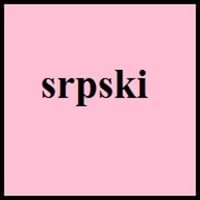Filipino vs Serbian
Countries
Philippines
Bosnia and Herzegovina, Kosovo, Serbia, Slovakia
National Language
Philippines
Bosnia, Croatia, Montenegro, Serbia
Second Language
Philippines
Not spoken in any of the countries
Speaking Continents
Asia
Europe
Minority Language
Not spoken in any of the countries
Croatia, Czech Republic, Hungary, Macedonia, Montenegro, Romania, Slovakia
Regulated By
Komisyon sa Wikang Filipino
Board for Standardization of the Serbian Language
Interesting Facts
- "Filipino" was officially declared as national language by the constitution in 1987.
- "Filipino" is the official name of Tagalog, or synonym of it.
- Serbian language was derived from the Old Church Salvic, as the language was commonly spoken by most of Slavic people in the 9th Century.
- Serbian language is based on Stokavian dialect.
Similar To
Tagalog Language
Bosnian and Croatian Languages
Derived From
Spanish Language
Not Available
Alphabets in
Filipino-Alphabets.jpg#200
Serbian-Alphabets.jpg#200
Scripts
Latin
Cyrillic, Latin
Writing Direction
Not Available
Left-To-Right, Horizontal
Hello
Kumusta
Здраво (Zdravo)
Thank You
Salamat
Хвала лепо (Hvala lepo)
How Are You?
Kumusta
Како си? (Kako si?)
Good Night
magandang gabi
Лаку ноћ (Laku noć)
Good Evening
Magandang gabi
Добро вече (Dobro veče)
Good Afternoon
Magandang hapon
Добар дан (Dobar dan)
Good Morning
Magandang umaga
Добро јутро (Dobro jutro)
Please
Mangyaring
Молим (Molim)
Sorry
pinagsisisihan
Жао ми је (Žao mi je)
Bye
Paalam
Довиђења (Doviđenja)
I Love You
Mahal kita
Волим те (Volim te)
Excuse Me
patawarin ninyo ako
Извините (Izvinite)
Dialect 1
Bikol
Prizren-Timok
Where They Speak
Philippines
Southeastern Serbia
Dialect 2
Hiligaynon
Smederevo–Vršac
Where They Speak
Philippines
Serbia
How Many People Speak
Not Available
Dialect 3
Waray
Torlakian
Where They Speak
Philippines
Bulgaria, France, Kosovo, Macedonia, Romania, Serbia
Speaking Population
Not Available
Not Available
Second Language Speakers
Not Available
Native Name
filipino
српски (srpski) српски језик (srpski jezik)
Alternative Names
Pilipino
Montenegrin
French Name
filipino; pilipino
serbe
German Name
Pilipino
Serbisch
Pronunciation
[ˌfɪl.ɪˈpiː.no]
[sr̩̂pskiː]
Ethnicity
Not Available
Serbs
Origin
16th Century
11th Century
Language Family
Austronesian Family
Indo-European Family
Subgroup
Not Available
Not Available
Branch
Not Available
Not Available
Early Forms
No early forms
No early forms
Standard Forms
Filipino
Standard Serbian
Language Position
Not Available
Signed Forms
Not Available
Not Available
Scope
Individual
Individual
ISO 639 1
No Data Available
sr
ISO 639 6
Not Available
Not Available
Glottocode
fili1244
serb1264
Linguasphere
No Data Available
53-AAA-g
Language Type
Living
Living
Language Linguistic Typology
Not Available
Subject-Verb-Object
Language Morphological Typology
Not Available
Not Available
Filipino and Serbian Language History
Comparison of Filipino vs Serbian language history gives us differences between origin of Filipino and Serbian language. History of Filipino language states that this language originated in 16th Century whereas history of Serbian language states that this language originated in 11th Century. Family of the language also forms a part of history of that language. More on language families of these languages can be found out on Filipino and Serbian Language History.
Filipino and Serbian Greetings
People around the world use different languages to interact with each other. Even if we cannot communicate fluently in any language, it will always be beneficial to know about some of the common greetings or phrases from that language. This is where Filipino and Serbian greetings helps you to understand basic phrases in Filipino and Serbian language. Filipino word for "Hello" is Kumusta or Serbian word for "Thank You" is Хвала лепо (Hvala lepo). Find more of such common Filipino Greetings and Serbian Greetings. These greetings will help you to be more confident when conversing with natives that speak these languages.
Filipino vs Serbian Difficulty
The Filipino vs Serbian difficulty level basically depends on the number of Filipino Alphabets and Serbian Alphabets. Also the number of vowels and consonants in the language plays an important role in deciding the difficulty level of that language. The important points to be considered when we compare Filipino and Serbian are the origin, speaking countries, language family, different greetings, speaking population of these languages. Want to know in Filipino and Serbian, which language is harder to learn? Time required to learn Filipino is 44 weeks while to learn Serbian time required is 44 weeks.





